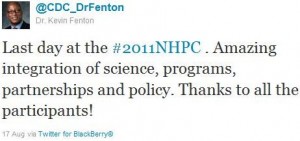Recapping Social Media for the National HIV Prevention Conference
As part of the planning and preparation for CDC’s 2011 National HIV Prevention ConferenceExit Disclaimer (NHPC), we reached out to the staff of our CDC National Prevention Information Network (NPIN) project to lend their expertise with social media outreach. Through our social media channels and activities we promoted the conference, informed followers of key deadlines, and assisted with networking for attendees and non-attendees. Using social media also facilitated our sharing of resources and partnering before, during, and after the conference. Our social media sites were promoted through e-mail outreach, the www.2011nhpc.orgExit Disclaimer web site, and using our key social media partners to cross-promote.
We set up a new Twitter account (@2011NHPCExit Disclaimer) and used it as a forum to send out information about the conference, educate about social media engagement at the conference, and build a connected follower base. We saw steady growth on our Twitter account leading up to the conference. New followers received information on conference deadlines and other planning. We even held a live pre-conference Twitter chat (#Exit Disclaimer) with the NPIN Twitter account (@CDCNPINExit Disclaimer).
We were pleased to see many Twitter followers “mention” @2011NHPCExit Disclaimer to reply and send messages to us, promote sessions and representation at the conference, discuss the conference, give suggestions and feedback, and signify excitement about conference activities and events. In 2011, there were 202 direct mentions (not including retweets of these messages).




We used the #2011NHPCExit Disclaimer hashtag to tie together conversations about the conference; it was promoted through the @2011NHPCExit Disclaimer Twitter account and all Twitter engagement with partners. By following the hashtag, all the tweets about the conference were unified into one conversation stream, making the discussions much easier to follow – for our stakeholders as well as us. During the month of August 2011, the #2011NHPC hashtag was used more than 2,600 times. The majority of the tweets that included the hashtag occurred during the duration of the conference, where tweeters promoted booth and session activities, live tweeted through plenaries and sessions, networked with colleagues and leaders, shared photos via Twitter, and provided valuable insight on their conference experiences.
We also had a NHPC Facebook fan pageExit Disclaimer – we shared information with fans through conference posts and photo sharing. Fans also posted their own information on sessions that they were hosting, asked questions, requested additional conference information, shared training and conference resources, and requested participation in events and for research. We noticed that most of the activity occurred in the month leading up to the conference, as fans began to prepare for the conference and network with colleagues. In the month of August, our fan page received 3,661 post views and 48 post feedback events.
The goals for both Twitter and Facebook were similar, yet we saw a difference between the types of audiences that interacted with the sites, and how they shared information. Organizations 'fan pages on Facebook interacted with the NHPC page by posting links and photos about their resources. Twitter followers showed their enthusiasm for accepted abstracts, planning, and attending the conference through conversations unified by the #2011NHPC hashtag.
Important leaders in HIV Prevention also participated in #2011NHPC conversations on Twitter. Dr. Kevin Fenton, Director of CDC National Center for HIV/AIDS, Viral Hepatitis, STDs, and Tuberculosis Prevention (@CDC_DrFenton) provided his insights on the conference and the important needs in HIV prevention in a Twitter interview with NPIN (@CDCNPINExit Disclaimer). Other key leaders also spoke with @CDCNPINExit Disclaimer on behalf of their organizations about their insights from the conference. Miguel Gomez, Director of HIV.gov (@AIDSgovExit Disclaimer) talked about the importance of new media to bring partners together at 2011 NHPC; and Paul Kawata spoke on behalf of the National Minority AIDS CouncilExit Disclaimer (@NMACCommunityExit Disclaimer) about key messages from the conference and expectations in the future of HIV prevention. Transcripts from these Twitter interviews can be found through the CDC NPIN Facebook pageExit Disclaimer Notes section. We greatly appreciate the time that each of these individuals committed to support the conference's social media activities.
Overall, our social media activities for NHPC provided an additional level of outreach for followers to become informed about and engage with us as well as other attendees. By engaging followers early and often, the NHPC social media accounts proved to be a valuable tool for conference planning, networking, and feedback.
Did you follow the 2011 NHPC on Twitter or Facebook? Are you using these tools for your next conference? Leave us a comment and tell us how you use social media to stay abreast at conferences.